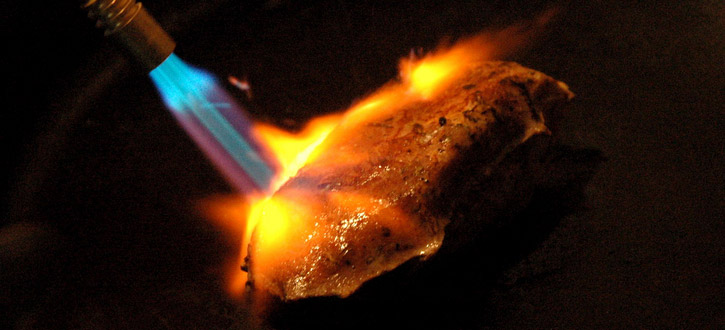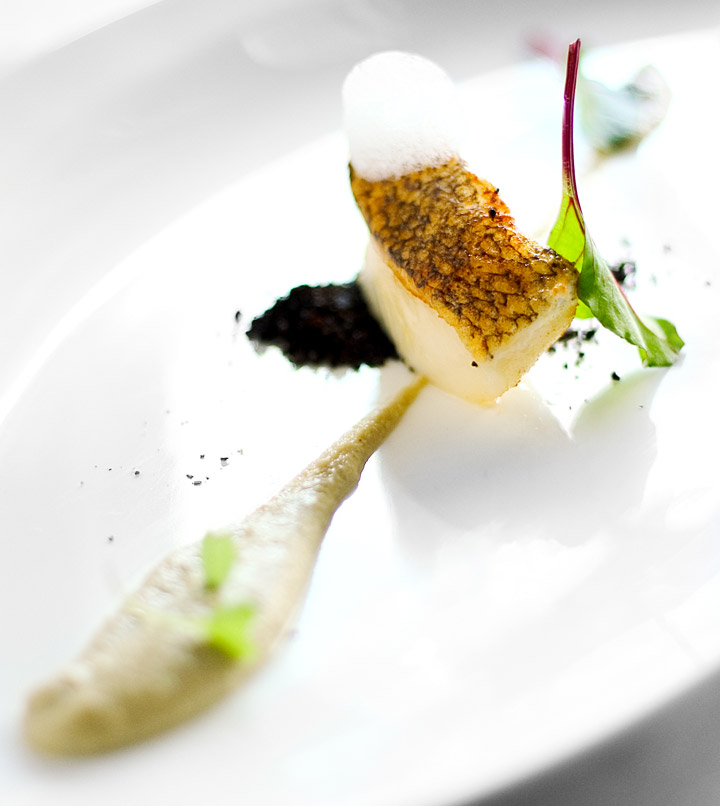Finishing Food After Sous Vide
Immediate Consumption After Cooking Sous Vide
After cooked sous vide, some foods can be served without any further process by just opening the pouch and placing it on the plate. Food that’s been cooked sous vide has the appearance of being poached; so fish, shellfish, eggs, and skinless poultry can be served as is; meat typically isn’t poached and is usually seared after cooking for both appearance and flavor.
The Perfect Sear
One of the hallmarks of a great steak is the beautiful brown sear on its outside. This flavorful, crispy skin gives the steak most of its flavor and can only be achieved at high temperature. Since sous-vide cooking never reaches high temperatures, you must always sear sous-vide cooked meat separately to achieve excellent browned flavor.
Searing before or after cooking can be done on a traditional stove-top with a pan, under a broiler, a griddle, a grill, with a blowtorch or even deep frying.
For small pieces of meat my favorite searing method is the blowtorch. Its high heat is very effective at creating the Maillard reaction without affecting the inside of the cut and it works well with foods of any shape. If using a blowtorch, MAPP gas is recommended to avoid adding unpleasant aromas.

For flat foods you can use a griddle or pan. Use a cast iron pan for beef, pork or chicken or stainless steel for more delicate food such as scallops or fish. To increase the temperature transfer, coat the pan with refined oil that has a higher smoke point such as canola or sunflower oil. Warm the pan, then add just enough oil to coat bottom of the pan but not too much, then wait until the oil starts smoking and turns brown to place the meat on the pan. Use paper towels to pat the meat dry before searing.
A very hot grill is also a good alternative when you want to obtain nice grill marks. Deep frying is great for large pieces of meat that have an odd shape but if not done correctly, it could result in greasy food. Modernist cuisine promotes the deep frying technique but they previously dip the meat in liquid nitrogen to prevent overcooking when deep frying.
In this recipe for Merluza Negra, Artichoke Cream, Olive Powder, and Sea Air, the Merluza Negra fish is cooked sous vide for 20 minutes, then seared for just 30 seconds before serving.

Seasoning after cooking Sous Vide
If you haven't seasoned the food before cooking sous vide, now is the time to do so. Season as you would normally do and prepare a sauce if desired.
Smoking after cooking Sous Vide
If you haven't smoked the food before cooking it sous vide, you can do it now. Controlling the temperature in a traditional smoker and avoiding overcooking the perfectly cooked food with sous vide could be tricky. If you decide to smoke after cooking sous vide, it may be better to use the cold smoking technique.
Sous Vide Cook - Chill - Freeze - Reheat
One advantage of sous vide cooking is that you can have the food pre-cooked and frozen in sealed pouches in the freezer, ready to be reheated and served when necessary. As long as you reheat it below the target cooking temperature, your food will be perfectly cooked. However, when using this process you need to be extra careful with food contamination and follow all necessary procedures to ensure the food is safe to eat. If you are not sure about all the steps, stick to immediate consumption after cooking sous vide.
- When cooking sous vide for chill - freeze - reheat, make sure the food is fresh and is not contaminated, blanch or sear it and cook it long enough to pasteurize it.
- Once the food is cooked and pasteurized, chill it right away in an ice water bath (half ice , half water) for 45 minutes.
- Freeze it.
- Reheat it in sous vide water bath at a temperature equal to or below the target doneness temperature. You can use the same sous vide water bath to reheat food that has been cooked at different temperatures as long as you reheat them using the lowest doneness temperature of all the portions. Reheating takes about 45 minutes per inch of thickness plus 30 minutes if the food was frozen.
- Sear, season or smoke if desired.





